Amateur holography - the beginning of the journey
I want to tell about one of my interests - optical holography. No, this is not about the holograms that are in Star Wars, or in the pyramids on the screens of mobile phones, not about the projection on the film, but what Wikipedia tells about in the corresponding article . I will not go into technical details and the wilds of equations (the processes are very complicated, and dozens of volume monographs are written on the subject), but I will try to very briefly describe what optical holography is and how it differs from photography in practical terms, what is so interesting and how is it possible to make the first real hologram at home? Although the process of recording holograms is similar to the classic analog photographic process, it still has a number of noticeable differences: other optical systems do not need a lens, photographic materials with a significantly higher resolution, monochromatic sources of radiation, no negative and positive, strict requirements for the absence are used vibrations, other scene composition rules and more other
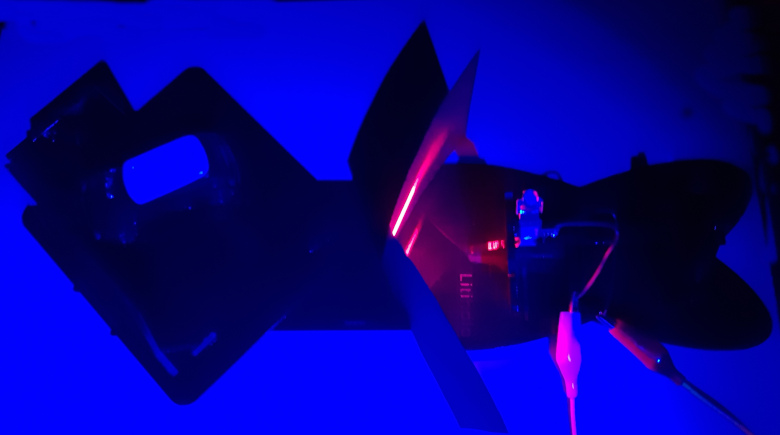
So, a classic color (in black and white, respectively, all the same) photography , both analog and digital, is capable of fixing only the amplitude of light waves, and by means of color separation indirectly the wavelength. It turns out a flat image of the scene strictly from one perspective and with colors, only with one success or another creating the illusion of the original colors for a person. Using the properties of binocular vision and special artistic techniques can give the image a certain amount, but also from only one angle, digital VR systems do not count, we are talking about a pure analogue.
A little-known Lippmann process , exploiting the phenomenon of interference , directly records and then reproduces the original spectral composition of the radiation. Due to the interference on the photographic plate, a complex picture of the interaction of all the waves from the scene is captured, and later diffraction on the resulting structure again restores these waves to exactly the same length and proportional amplitude. It turns out an image similar to photographic, but with accurate transmission of the emission spectrum without using color separation and other tweaks. Why did this method not supplant the traditional color photograph, especially considering that it appeared long before it? Firstly, high complexity: special high-resolution photographic materials are needed, a special mirror is tightly attached to the photographic emulsion (liquid mercury was originally used), chemical treatment, the resulting image is reproduced only under certain angles of illumination and observation, and so forth. Secondly, and so well , obtained by additive color mixing for a person visually identical to the original wavelengths.
')
Optical holography, as well as the Lippmann process, exploits the phenomenon of interference and captures not only the intensity, but also the phase of the light wave, and therefore the direction of incidence of each beam in the scene. Therefore, the technology was called holography, which translates as “full” from the ancient Greek, and I write, that is, a complete record, while keeping all the information about the light falling on the recording medium. And when playing a holographic image is obtained almost indistinguishable from the original at the time of recording, three-dimensional and allowing to see the captured object from different angles within a certain angle. If there are shadows, highlights, reflections, refractions, then they will reliably be transmitted, such a ray tracing.
For example, a very successful color hologram (not mine):
The dynamic range of the scene can reach a fantastic 1: 1 000 000. The hologram plays the role of a window through which you can observe the scene as it was at the time of recording. Each hologram point carries information about all fallen rays from the whole scene. Therefore, by dividing a hologram into several parts, we will lose some information about the scene, but not in such a volume as in the case of a classic photo, in the case of a hologram, by changing the angle you can see objects of the scene that would be completely lost in the case of an ordinary photo. Of course, the use of holography is not limited to artistic holography, it is the control of structural materials and technological processes, and scientific research, and holographic optical elements, and promising ways of storing information, and methods for processing information, and more. other
How does a hologram record happen? As a rule, this requires two coherent light beams, one reference, comes directly from the laser, does not transform at all, and directly falls on the recording medium. The second is reflected from the objects of the scene and carries information about it. It is they who interfere with each other, and the resulting pattern of interference fringes is fixed by photographic material. Then, due to the diffraction on the obtained structure of only one reference beam, which does not carry any information, the object (second beam) is restored and the image of the captured scene appears, and the coded information is restored.
There are many types of holograms and ways to record them, the two most simple and visual schemes are the Leith-Upatnieks scheme, which gives the transmissive holograms, in it both the reference beam and the object fall on the photographic material from one side. And the Denisyuk scheme, which gives reflective holograms, when the beams fall from different sides. The first ones can be reproduced only with the help of a laser, but have a very high brightness and a degree of realism, but with them it is difficult to get a color image. The latter can be reproduced in ordinary white light, the hologram itself cuts out the wavelengths it needs from the incident light, and when recording a hologram with three lasers at the same time, you can get a color image. Both methods have application and are easily realized, especially the second, for which it is enough to put a photographic plate on the object and light it from the side of the plate with a laser. I will not insert someone else's pictures with the schemes, which are in the same Wikipedia, I will focus on the practical part. Noting only that the disadvantage, apart from the complexity of the process, is the need to use highly coherent, which means monochromatic radiation, and it will also be necessary to use three sources of radiation to record a color image. And also, as in the case of the Lippmann process, holograms have special requirements for lighting. It is also possible to calculate a diffraction pattern on a computer and then record it on a photographic material. There, holograms are created in large sizes, with complex effects or objects that do not exist in reality.
What is necessary to record a holographic image - the creation of an optical hologram?
The first. The most important, important and difficult is the high mechanical stability of all structures, the complete absence of any movements, vibrations, even from voice or thermal expansion, not to mention the old refrigerator in the corner. So, the object and photographic material should not be displaced relative to each other by more than ¼ of the wavelength of the recording laser in the recording process, as you can easily count it. Various techniques are used for this, from placing objects directly on photographic material, or photographic material on objects, to optical tables weighing hundreds of kilograms with active pneumatic supports. Vibration requirements are significantly mitigated when using a pulsed laser, but the laser itself becomes the most complex and expensive part of the system.
The second. Special photographic materials with high resolution (from 1,000 to 5,000 lin./mm and above) and created specifically for fixing the interference pattern using one or other schemes. Existing types of recording materials:
In the west, dichromate gelatin is most popular with amateurs and in commercial practice, due to its low cost, high brightness of the resulting image, and availability of powerful green and blue lasers. On the territory of the former USSR there are silver halide, for which a small helium-neon laser or even a simple red laser pointer is sufficient. For the first experiments, the easiest way is to purchase and use photopolymer materials, one of the brands will be discussed below. Industrial holograms (for example, to protect products from counterfeiting) are produced by the imprint method on a mirrored plastic film, but they are also pre-recorded with a laser and go through several stages of transformation to the so-called. rainbow holograms.
Third. The laser, like the mechanics, must be very stable, and the requirements for stability are extremely high. First of all, it should be single-mode, as in transverse modes (one single beam of radiation), Eng. single transverse, TEM 00 , and along the longitudinal (one radiation frequency), eng. single longitudinal. Here is the latest characteristic and you need to look for a suitable laser. For holography, in addition to the wavelength, such a radiation parameter as temporal coherence is extremely important. In general terms, it determines the stability of the radiation parameters in time, the maximum possible time for one beam to lag behind the other, in which an interference pattern will be observed. Since the speed of light is very high, it is more convenient to manipulate the coherence length (how much light passes during the coherence time). The line width of the laser radiation is related to the coherence length by the formula: central_length ^ 2 / width_line. So for a coherence length of 10 cm, the laser linewidth for 650 nm should be 0.004 nm.
The coherence length of the laser limits the maximum depth of the hologram scene, but for different schemes in different ways. For example, for the Denisyuk recording scheme, where the object is located behind the photographic plate, the difference in the course of the object and reference beam will be approximately the distance that the beam traveled from the photographic plate to the object and back. And the maximum depth of the stage will be about half the coherence length. In the case of the Leith-Upatnieks scheme, everything depends on the method of illumination, the presence and position of the mirrors and the beam-splitting plate, and it is quite possible to achieve a maximum depth of the scene approximately equal to the coherence length.
Fortunately, quite a few types of lasers with the right approach are able to give the desired characteristics, especially in the field of low power. So many helium-neon lasers have radiation with a coherence length of about 15 cm and more with power up to tens of mW. Oddly enough, most inexpensive red laser pointers and low-power modules of up to 5 mW are also quite suitable, and can produce radiation with a coherence length from a centimeter to several meters. But green and blue laser pointers are often not suitable for anything more than to record a scene with coins several millimeters deep, but here you need to study each copy separately, it will be a little lower. In general, a review of lasers, their choice, methods of feeding and stabilization is a topic for another, rather voluminous article.
We turn directly to the practical part. For the first experiments, a ready-made set for experiments in the field of holography was chosen, including a suitable laser with a power supply unit on batteries, photopolymer holographic plates, some mechanics, documentation and other auxiliary objects such as a key fob with a blue LED as a non-actinic source ) light - Litiholo hologram kit with Reflection upgrade supplement.
Photographic materials. Photopolymer with a protective layer on optical glass with a thickness of 1.8 mm, the stated diffraction efficiency (something like efficiency in this case) is more than 90%, the sensitivity is in the range from 400 to 690 nm, i.e., color holograms can also be recorded. Suitable for recording transmissive and reflective holograms. Photographic plates before exposure to violet color, after irradiation with a laser in the most illuminated places, become discolored, complete discoloration is performed with bright white light, no other procedure of development or fixation is required.
Laser. A 638 nm semiconductor laser module with a declared power of 5 mW has a variable resistor for fine tuning of the current, and a power supply unit on batteries, declared as suitable for holography.
In accordance with the complete instruction, a scheme was assembled to record the transmissive holograms.
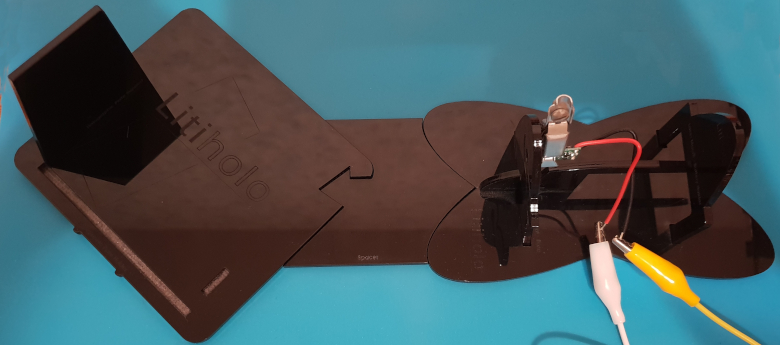
The laser was pre-heated (left on) for 15 minutes, and the generated spectrum was tested in the simplest way: a sheet of white paper is installed behind the laser, and in front of it a glass plate parallel to the paper sheet and a glass plate perpendicular to the beam ( for a microscope or a photographic plate with the sensitive layer removed), a clear interference pattern consisting of bright and dark stripes should be observed on the sheet, weaker ones should be absent in dark gaps light stripes, and the picture itself should be stable in time and as contrasting as possible. If the bands are not observed, are shifted in time, or the picture has a very low contrast, it does not make much sense to try to record a hologram, you need to change the laser current, give more time to warm up and / or replace the laser itself. If the picture is clear and without intermediate bands, then we can say that the coherence length is not less than the thickness of the plate * 2 * coefficient of refraction. So with a glass thickness of 1.8 mm, this number will be 5.5 mm, because it is better to find glass thicker or better a set of glasses of different thickness. Most likely, the coherence length will be even longer, since without instrumental methods of measurement, the contrast assessment is too subjective. More precisely, it will be possible to say by recording a hologram or using a Michelson interferometer .
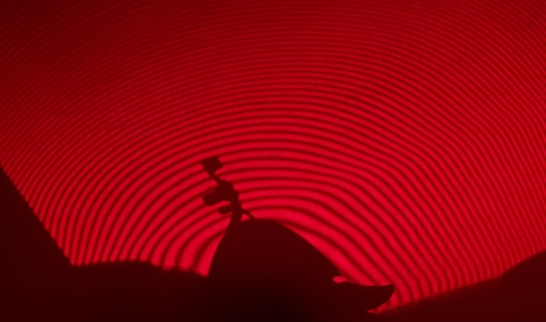
Then a hologram was recorded of the complete object, car model.
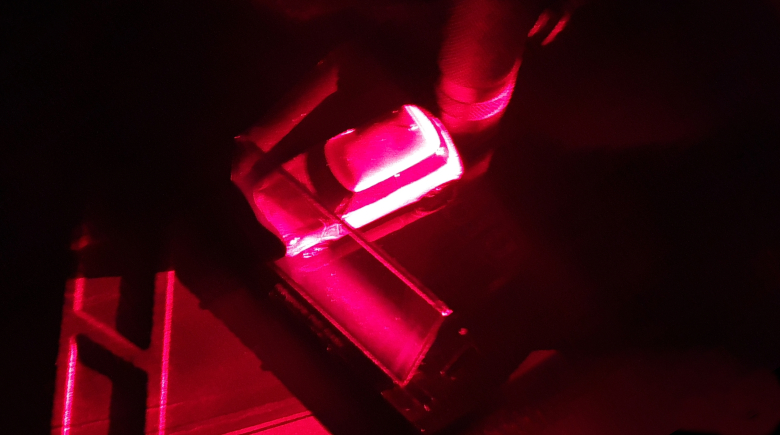
Unfortunately, the camera does not transmit the dynamic range of the resulting images of their brightness and volume. When you remove an object live, you get the feeling that nothing has changed, that the object is still there, only its illumination changes a little, the volume, reflections, shadows, highlights and the possibility of changing the viewing angle remain. The image appears only in the light of the laser radiation incident on the angle of incidence of the reference beam.

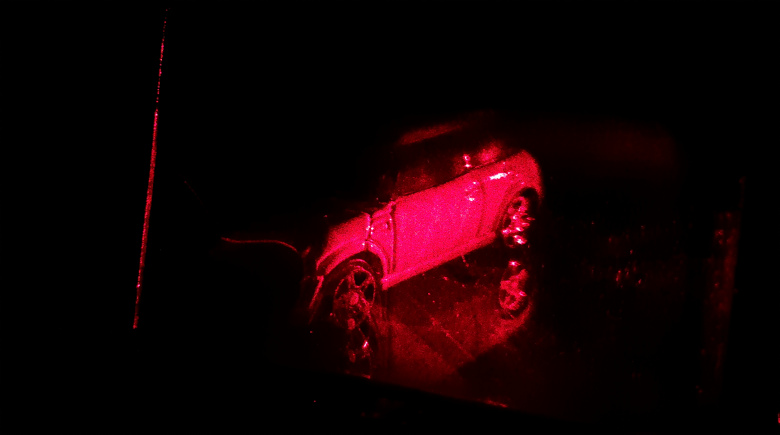
The following was collected scheme for recording reflective holograms using additional parts from the Reflection upgrade, which are deprived of the above voiced deficiency and are visible in white light.
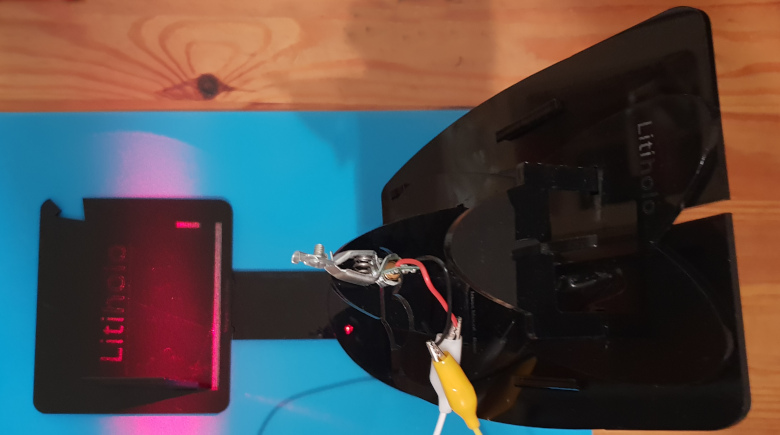
Here it is necessary to construct a tower for a laser, and we are not talking about any part of the wavelength. However, this requirement applies only to the relative position of the object and photographic material, and some optical elements, the laser simply does not have to openly dangle, and everything will be fine.

The resulting holograms are visible in white light, best suited to the sun or from halogen lamps, with a continuous spectrum, and the angle of incidence of the light beam should be the same as when recording. The color ratio of the light source is extremely important, since the reflective hologram creates an image reflecting a certain range of wavelengths, and skips the rest, and this very range for maximum brightness of the image must be contained in the light in full. Since the recording is carried out by a red laser, this range is red-yellow, the color depends on the angle of incidence of the light, and the image is a bit more pleasant looking than monochrome in the light of laser radiation.

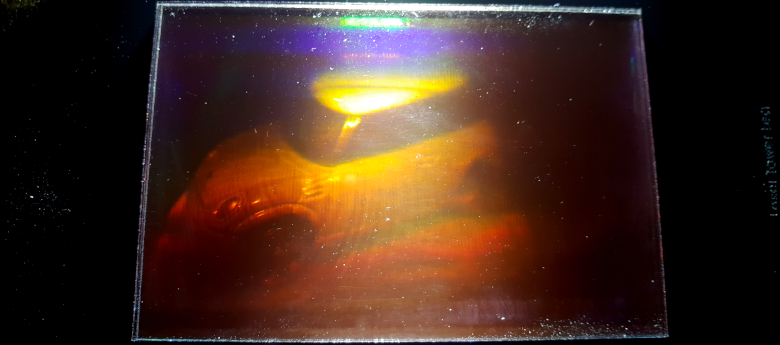
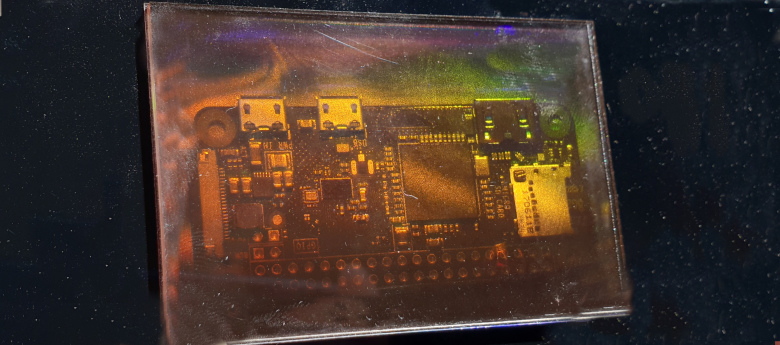

The holograms turned out, and it shows how easy it is to start (and for someone to finish, if not hooked) to develop in this rather popular hobby in the West, which is almost forgotten in the post-Soviet space, which may well turn into a professional and commercial course. , for example the manufacture of fine holograms to order. It is also a great topic for attracting students' interest in science, circle activities, the first scientific papers, affecting and able to integrate many sections of physics, engineering, technology, chemistry, radio electronics, information technology.
If the topic arouses interest, I will try to write more about the mechanics, optics, lasers, photographic materials, including self-made ones, etc. I will also be happy to take into account all the comments and suggestions, I will supplement the article with information missing from the readers.
For a deeper study of the issue I can also recommend the following sources:

So, a classic color (in black and white, respectively, all the same) photography , both analog and digital, is capable of fixing only the amplitude of light waves, and by means of color separation indirectly the wavelength. It turns out a flat image of the scene strictly from one perspective and with colors, only with one success or another creating the illusion of the original colors for a person. Using the properties of binocular vision and special artistic techniques can give the image a certain amount, but also from only one angle, digital VR systems do not count, we are talking about a pure analogue.
A little-known Lippmann process , exploiting the phenomenon of interference , directly records and then reproduces the original spectral composition of the radiation. Due to the interference on the photographic plate, a complex picture of the interaction of all the waves from the scene is captured, and later diffraction on the resulting structure again restores these waves to exactly the same length and proportional amplitude. It turns out an image similar to photographic, but with accurate transmission of the emission spectrum without using color separation and other tweaks. Why did this method not supplant the traditional color photograph, especially considering that it appeared long before it? Firstly, high complexity: special high-resolution photographic materials are needed, a special mirror is tightly attached to the photographic emulsion (liquid mercury was originally used), chemical treatment, the resulting image is reproduced only under certain angles of illumination and observation, and so forth. Secondly, and so well , obtained by additive color mixing for a person visually identical to the original wavelengths.
')
Optical holography, as well as the Lippmann process, exploits the phenomenon of interference and captures not only the intensity, but also the phase of the light wave, and therefore the direction of incidence of each beam in the scene. Therefore, the technology was called holography, which translates as “full” from the ancient Greek, and I write, that is, a complete record, while keeping all the information about the light falling on the recording medium. And when playing a holographic image is obtained almost indistinguishable from the original at the time of recording, three-dimensional and allowing to see the captured object from different angles within a certain angle. If there are shadows, highlights, reflections, refractions, then they will reliably be transmitted, such a ray tracing.
For example, a very successful color hologram (not mine):
The dynamic range of the scene can reach a fantastic 1: 1 000 000. The hologram plays the role of a window through which you can observe the scene as it was at the time of recording. Each hologram point carries information about all fallen rays from the whole scene. Therefore, by dividing a hologram into several parts, we will lose some information about the scene, but not in such a volume as in the case of a classic photo, in the case of a hologram, by changing the angle you can see objects of the scene that would be completely lost in the case of an ordinary photo. Of course, the use of holography is not limited to artistic holography, it is the control of structural materials and technological processes, and scientific research, and holographic optical elements, and promising ways of storing information, and methods for processing information, and more. other
How does a hologram record happen? As a rule, this requires two coherent light beams, one reference, comes directly from the laser, does not transform at all, and directly falls on the recording medium. The second is reflected from the objects of the scene and carries information about it. It is they who interfere with each other, and the resulting pattern of interference fringes is fixed by photographic material. Then, due to the diffraction on the obtained structure of only one reference beam, which does not carry any information, the object (second beam) is restored and the image of the captured scene appears, and the coded information is restored.
There are many types of holograms and ways to record them, the two most simple and visual schemes are the Leith-Upatnieks scheme, which gives the transmissive holograms, in it both the reference beam and the object fall on the photographic material from one side. And the Denisyuk scheme, which gives reflective holograms, when the beams fall from different sides. The first ones can be reproduced only with the help of a laser, but have a very high brightness and a degree of realism, but with them it is difficult to get a color image. The latter can be reproduced in ordinary white light, the hologram itself cuts out the wavelengths it needs from the incident light, and when recording a hologram with three lasers at the same time, you can get a color image. Both methods have application and are easily realized, especially the second, for which it is enough to put a photographic plate on the object and light it from the side of the plate with a laser. I will not insert someone else's pictures with the schemes, which are in the same Wikipedia, I will focus on the practical part. Noting only that the disadvantage, apart from the complexity of the process, is the need to use highly coherent, which means monochromatic radiation, and it will also be necessary to use three sources of radiation to record a color image. And also, as in the case of the Lippmann process, holograms have special requirements for lighting. It is also possible to calculate a diffraction pattern on a computer and then record it on a photographic material. There, holograms are created in large sizes, with complex effects or objects that do not exist in reality.
What is necessary to record a holographic image - the creation of an optical hologram?
The first. The most important, important and difficult is the high mechanical stability of all structures, the complete absence of any movements, vibrations, even from voice or thermal expansion, not to mention the old refrigerator in the corner. So, the object and photographic material should not be displaced relative to each other by more than ¼ of the wavelength of the recording laser in the recording process, as you can easily count it. Various techniques are used for this, from placing objects directly on photographic material, or photographic material on objects, to optical tables weighing hundreds of kilograms with active pneumatic supports. Vibration requirements are significantly mitigated when using a pulsed laser, but the laser itself becomes the most complex and expensive part of the system.
The second. Special photographic materials with high resolution (from 1,000 to 5,000 lin./mm and above) and created specifically for fixing the interference pattern using one or other schemes. Existing types of recording materials:
- Silver halide.
They are very similar to classic photographic materials, but have significantly higher resolution and are sensitized for specific laser wavelengths.
Advantages: they have the highest sensitivity, which means they require the shortest exposures, and as a result, they have less problems with vibrations, and also make it easy to use low-power lasers; Using a combination of sensitizing dyes, photographic materials for color holography can be obtained by analogy with color photography; relatively not expensive, can be easily purchased and even made independently. Can be used in conjunction with a pulsed laser that allows you to take pictures of living and other moving objects, up to falling water.
Disadvantages: have a relatively low brightness without additional bleaching procedures; require precise exposure of the exposure and chemical treatment, especially responsible stage of manifestation; have limited permission. - Bichromated gelatin.
Advantages: the highest brightness of the received images; low cost and ease of manufacture; simplicity of the development procedure; extremely high resolution.
Disadvantages: very low sensitivity, mainly sensitive in the blue region of the spectrum, the red shift in sensitivity and sensitivity increase are very complex and require scarce chemical compounds; high hygroscopicity, full sealing is required. - Photopolymers.
Advantages: high brightness of the received images; low cost and ease of manufacture (but more expensive and more difficult to dichromate gelatin); do not require development; relatively high sensitivity; can be, as well as silver halide, made sensitive to the entire region of the visible spectrum; have extremely high resolution.
Disadvantages: the toxicity of their constituent components (important in the manufacture at home); poor persistence of the resulting image in some recipes. - Photochromic crystals and other exotic.
There are mainly in specialized laboratories.
In the west, dichromate gelatin is most popular with amateurs and in commercial practice, due to its low cost, high brightness of the resulting image, and availability of powerful green and blue lasers. On the territory of the former USSR there are silver halide, for which a small helium-neon laser or even a simple red laser pointer is sufficient. For the first experiments, the easiest way is to purchase and use photopolymer materials, one of the brands will be discussed below. Industrial holograms (for example, to protect products from counterfeiting) are produced by the imprint method on a mirrored plastic film, but they are also pre-recorded with a laser and go through several stages of transformation to the so-called. rainbow holograms.
Third. The laser, like the mechanics, must be very stable, and the requirements for stability are extremely high. First of all, it should be single-mode, as in transverse modes (one single beam of radiation), Eng. single transverse, TEM 00 , and along the longitudinal (one radiation frequency), eng. single longitudinal. Here is the latest characteristic and you need to look for a suitable laser. For holography, in addition to the wavelength, such a radiation parameter as temporal coherence is extremely important. In general terms, it determines the stability of the radiation parameters in time, the maximum possible time for one beam to lag behind the other, in which an interference pattern will be observed. Since the speed of light is very high, it is more convenient to manipulate the coherence length (how much light passes during the coherence time). The line width of the laser radiation is related to the coherence length by the formula: central_length ^ 2 / width_line. So for a coherence length of 10 cm, the laser linewidth for 650 nm should be 0.004 nm.
The coherence length of the laser limits the maximum depth of the hologram scene, but for different schemes in different ways. For example, for the Denisyuk recording scheme, where the object is located behind the photographic plate, the difference in the course of the object and reference beam will be approximately the distance that the beam traveled from the photographic plate to the object and back. And the maximum depth of the stage will be about half the coherence length. In the case of the Leith-Upatnieks scheme, everything depends on the method of illumination, the presence and position of the mirrors and the beam-splitting plate, and it is quite possible to achieve a maximum depth of the scene approximately equal to the coherence length.
Fortunately, quite a few types of lasers with the right approach are able to give the desired characteristics, especially in the field of low power. So many helium-neon lasers have radiation with a coherence length of about 15 cm and more with power up to tens of mW. Oddly enough, most inexpensive red laser pointers and low-power modules of up to 5 mW are also quite suitable, and can produce radiation with a coherence length from a centimeter to several meters. But green and blue laser pointers are often not suitable for anything more than to record a scene with coins several millimeters deep, but here you need to study each copy separately, it will be a little lower. In general, a review of lasers, their choice, methods of feeding and stabilization is a topic for another, rather voluminous article.
We turn directly to the practical part. For the first experiments, a ready-made set for experiments in the field of holography was chosen, including a suitable laser with a power supply unit on batteries, photopolymer holographic plates, some mechanics, documentation and other auxiliary objects such as a key fob with a blue LED as a non-actinic source ) light - Litiholo hologram kit with Reflection upgrade supplement.
Photographic materials. Photopolymer with a protective layer on optical glass with a thickness of 1.8 mm, the stated diffraction efficiency (something like efficiency in this case) is more than 90%, the sensitivity is in the range from 400 to 690 nm, i.e., color holograms can also be recorded. Suitable for recording transmissive and reflective holograms. Photographic plates before exposure to violet color, after irradiation with a laser in the most illuminated places, become discolored, complete discoloration is performed with bright white light, no other procedure of development or fixation is required.
Laser. A 638 nm semiconductor laser module with a declared power of 5 mW has a variable resistor for fine tuning of the current, and a power supply unit on batteries, declared as suitable for holography.
In accordance with the complete instruction, a scheme was assembled to record the transmissive holograms.

The laser was pre-heated (left on) for 15 minutes, and the generated spectrum was tested in the simplest way: a sheet of white paper is installed behind the laser, and in front of it a glass plate parallel to the paper sheet and a glass plate perpendicular to the beam ( for a microscope or a photographic plate with the sensitive layer removed), a clear interference pattern consisting of bright and dark stripes should be observed on the sheet, weaker ones should be absent in dark gaps light stripes, and the picture itself should be stable in time and as contrasting as possible. If the bands are not observed, are shifted in time, or the picture has a very low contrast, it does not make much sense to try to record a hologram, you need to change the laser current, give more time to warm up and / or replace the laser itself. If the picture is clear and without intermediate bands, then we can say that the coherence length is not less than the thickness of the plate * 2 * coefficient of refraction. So with a glass thickness of 1.8 mm, this number will be 5.5 mm, because it is better to find glass thicker or better a set of glasses of different thickness. Most likely, the coherence length will be even longer, since without instrumental methods of measurement, the contrast assessment is too subjective. More precisely, it will be possible to say by recording a hologram or using a Michelson interferometer .

Then a hologram was recorded of the complete object, car model.

Unfortunately, the camera does not transmit the dynamic range of the resulting images of their brightness and volume. When you remove an object live, you get the feeling that nothing has changed, that the object is still there, only its illumination changes a little, the volume, reflections, shadows, highlights and the possibility of changing the viewing angle remain. The image appears only in the light of the laser radiation incident on the angle of incidence of the reference beam.


The following was collected scheme for recording reflective holograms using additional parts from the Reflection upgrade, which are deprived of the above voiced deficiency and are visible in white light.

Here it is necessary to construct a tower for a laser, and we are not talking about any part of the wavelength. However, this requirement applies only to the relative position of the object and photographic material, and some optical elements, the laser simply does not have to openly dangle, and everything will be fine.

The resulting holograms are visible in white light, best suited to the sun or from halogen lamps, with a continuous spectrum, and the angle of incidence of the light beam should be the same as when recording. The color ratio of the light source is extremely important, since the reflective hologram creates an image reflecting a certain range of wavelengths, and skips the rest, and this very range for maximum brightness of the image must be contained in the light in full. Since the recording is carried out by a red laser, this range is red-yellow, the color depends on the angle of incidence of the light, and the image is a bit more pleasant looking than monochrome in the light of laser radiation.




The holograms turned out, and it shows how easy it is to start (and for someone to finish, if not hooked) to develop in this rather popular hobby in the West, which is almost forgotten in the post-Soviet space, which may well turn into a professional and commercial course. , for example the manufacture of fine holograms to order. It is also a great topic for attracting students' interest in science, circle activities, the first scientific papers, affecting and able to integrate many sections of physics, engineering, technology, chemistry, radio electronics, information technology.
If the topic arouses interest, I will try to write more about the mechanics, optics, lasers, photographic materials, including self-made ones, etc. I will also be happy to take into account all the comments and suggestions, I will supplement the article with information missing from the readers.
For a deeper study of the issue I can also recommend the following sources:
- Holowiki
- Holographyforum
- holography.ru
- Holography for the curious. A book for school staff. A.A. Akilov, M.K. Shevtsov. M. Publishing Solutions, 2018.
- F. Unterseher, B. Schlesinger, J. Hansen. Holography Handbook: Making Holograms the Easy Way. Ross Books; 3 edition, 2010.
- G. Saxby, S. Zacharovas. Practical Holography. CRC Press; 4 edition, 2015.
- G. Saxby. The Manual of Practical Holography. Focal Pr, 1991.
- Ultra-Realistic Imaging: Advanced Techniques and Digital Color Holography. Hans Bjelkhagen, David Brotherton-Ratcliffe. CRC Press, 2013.
- Shoebox Holography: A Step-By-Step Guide To Making Holograms Using Inexpensive Semiconductor Diode Lasers. Frank DeFreitas, Steve Michael, Alan Rhody. Ross Books, 2000.
Source: https://habr.com/ru/post/444718/
All Articles